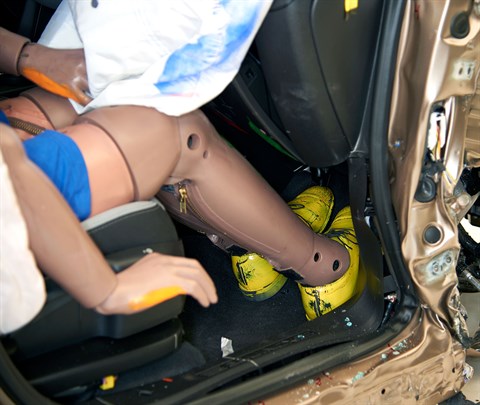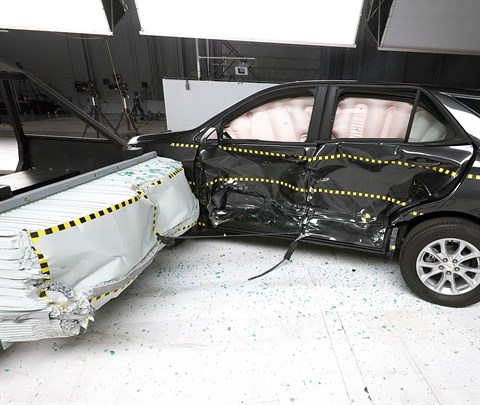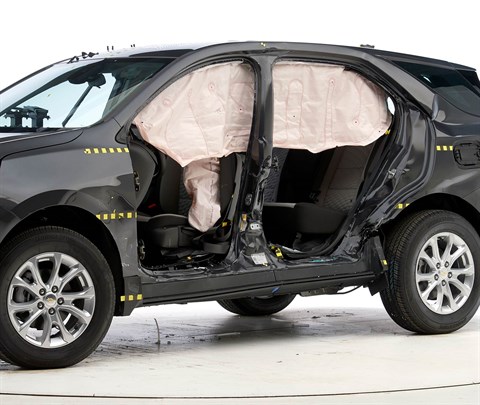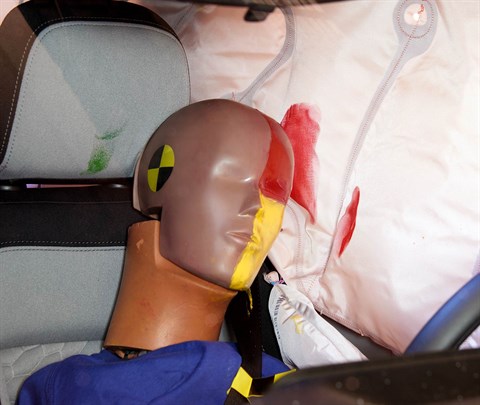Small overlap front: driver-side
Rating applies to 2018-24 models
Tested vehicle: 2018 Chevrolet Equinox LT 4-door 4wd
The Chevrolet Equinox and GMC Terrain were redesigned for the 2018 model year. Both vehicles are smaller and lighter than the earlier design and therefore are now classified as small SUVs. Driver-side small overlap frontal ratings are assigned by the Institute based on a test conducted by General Motors.
| Overall evaluation | |
|---|---|
| Structure and safety cage | |
| Driver injury measures | |
| Head/neck | |
| Chest | |
| Hip/thigh | |
| Lower leg/foot | |
| Driver restraints and dummy kinematics |
Measures of occupant compartment intrusion on driver side
| Test ID | VTN1801 |
|---|---|
| Lower occupant compartment | |
| Lower hinge pillar max (cm) | 6 |
| Footrest (cm) | 5 |
| Left toepan (cm) | 4 |
| Brake pedal (cm) | 5 |
| Parking brake (cm) | |
| Rocker panel lateral average (cm) | 1 |
| Upper occupant compartment | |
| Steering column | 0 |
| Upper hinge pillar max (cm) | 5 |
| Upper dash (cm) | 5 |
| Lower instrument panel (cm) | 5 |
Driver injury measures
| Test ID | VTN1801 |
|---|---|
| Head | |
| HIC-15 | 86 |
| Peak gs at hard contact | no contact |
| Neck | |
| Tension (kN) | 0.8 |
| Extension bending moment (Nm) | 8 |
| Maximum Nij | 0.17 |
| Chest maximum compression (mm) | 22 |
| Femur (kN) | |
| Left | 0.7 |
| Right | 0.1 |
| Knee displacement (mm) | |
| Left | 0 |
| Right | 0 |
| Knee-thigh-hip injury risk (%) | |
| Left | 0 |
| Right | 0 |
| Maximum tibia index | |
| Left | 0.47 |
| Right | 0.51 |
| Tibia axial force (kN) | |
| Left | 1.2 |
| Right | 0.2 |
| Foot acceleration (g) | |
| Left | 56 |
| Right | 43 |
Small overlap front: passenger-side
Rating applies to 2018-24 models
Tested vehicle: 2018 Chevrolet Equinox LS 4-door 4wd
The Chevrolet Equinox and GMC Terrain were redesigned for the 2018 model year. Both vehicles are smaller and lighter than the earlier design and therefore are now classified as small SUVs.
| Overall evaluation | |
|---|---|
| Structure and safety cage | |
| Passenger injury measures | |
| Head/neck | |
| Chest | |
| Hip/thigh | |
| Lower leg/foot | |
| Passenger restraints and dummy kinematics | |
| Driver injury measures | |
| Head/neck | |
| Chest | |
| Hip/thigh | |
| Lower leg/foot | |
| Driver restraints and dummy kinematics |

Action shot taken during the passenger-side small overlap frontal crash test.

The dummy's position in relation to the door frame and dashboard after the crash test indicates that the passenger’s survival space was maintained reasonably well.

The frontal and side curtain airbags worked well together to keep the passenger dummy’s head from coming close to any stiff structure or outside objects that could cause injury.

Intrusion of the dashboard and door hinge pillar contributed to a moderate risk of injury to the right lower leg.
Measures of occupant compartment intrusion on passenger side
| Test ID | CEP1811 |
|---|---|
| Lower occupant compartment | |
| Lower hinge pillar max (cm) | 11 |
| Footrest (cm) | 7 |
| Right toepan (cm) | 3 |
| Center toepan (cm) | 2 |
| Rocker panel lateral average (cm) | 2 |
| Upper occupant compartment | |
| Center dash (cm) | 6 |
| Upper hinge pillar max (cm) | 11 |
| Upper dash (cm) | 9 |
| Right lower dash (cm) | 11 |
Passenger injury measures
| Test ID | CEP1811 |
|---|---|
| Head | |
| HIC-15 | 109 |
| Peak gs at hard contact | no contact |
| Neck | |
| Tension (kN) | 1.0 |
| Extension bending moment (Nm) | 16 |
| Maximum Nij | 0.25 |
| Chest maximum compression (mm) | 16 |
| Femur (kN) | |
| Left | 0.0 |
| Right | 1.1 |
| Knee displacement (mm) | |
| Left | 1 |
| Right | 9 |
| Knee-thigh-hip injury risk (%) | |
| Left | 0 |
| Right | 0 |
| Maximum tibia index | |
| Left | 0.43 |
| Right | 0.82 |
| Tibia axial force (kN) | |
| Left | 1.8 |
| Right | 1.0 |
| Foot acceleration (g) | |
| Left | 63 |
| Right | 41 |
Driver injury measures
| Test ID | CEP1811 |
|---|---|
| Head | |
| HIC-15 | 90 |
| Peak gs at hard contact | no contact |
| Neck | |
| Tension (kN) | 0.8 |
| Extension bending moment (Nm) | 14 |
| Maximum Nij | 0.16 |
| Chest maximum compression (mm) | 28 |
| Femur (kN) | |
| Left | 0.2 |
| Right | 0.2 |
| Knee displacement (mm) | |
| Left | 0 |
| Right | 0 |
| Knee-thigh-hip injury risk (%) | |
| Left | 0 |
| Right | 0 |
| Maximum tibia index | |
| Left | 0.28 |
| Right | 0.19 |
| Tibia axial force (kN) | |
| Left | 0.2 |
| Right | 0.2 |
| Foot acceleration (g) | |
| Left | 54 |
| Right | 42 |
Moderate overlap front: original test
Rating applies to 2018-24 models
Tested vehicle: 2018 Chevrolet Equinox Premier 4-door 4wd
The Chevrolet Equinox and GMC Terrain were redesigned for the 2018 model year. Both vehicles are smaller and lighter than the earlier design and therefore are now classified as small SUVs. Moderate overlap frontal ratings are assigned by the Institute based on a test conducted by General Motors.
| Overall evaluation | |
|---|---|
| Structure and safety cage | |
| Driver injury measures | |
| Head/neck | |
| Chest | |
| Leg/foot, left | |
| Leg/foot, right | |
| Driver restraints and dummy kinematics |
Measures of occupant compartment intrusion on driver side
| Test ID | VTF1801 |
|---|---|
| Footwell intrusion | |
| Footrest (cm) | 5 |
| Left (cm) | 7 |
| Center (cm) | 7 |
| Right (cm) | 6 |
| Brake pedal (cm) | 7 |
| Instrument panel rearward movement | |
| Left (cm) | 0 |
| Right (cm) | 0 |
| Steering column movement | |
| Upward (cm) | -3 |
| Rearward (cm) | 1 |
| A-pillar rearward movement (cm) | 1 |
Driver injury measures
| Test ID | VTF1801 |
|---|---|
| Head | |
| HIC-15 | 163 |
| Peak gs at hard contact | no contact |
| Neck | |
| Tension (kN) | 0.9 |
| Extension bending moment (Nm) | 4 |
| Maximum Nij | 0.20 |
| Chest maximum compression (mm) | 25 |
| Legs | |
| Femur force - left (kN) | 1.0 |
| Femur force - right (kN) | 0.4 |
| Knee displacement - left (mm) | 0 |
| Knee displacement - right (mm) | 0 |
| Maximum tibia index - left | 0.34 |
| Maximum tibia index - right | 0.67 |
| Tibia axial force - left (kN) | 1.7 |
| Tibia axial force - right (kN) | 3.0 |
| Foot acceleration (g) | |
| Left | 54 |
| Right | 81 |
Side: original test
Rating applies to 2018-24 models
Tested vehicle: 2018 Chevrolet Equinox Premier 4-door 4wd
The Chevrolet Equinox and GMC Terrain were redesigned for the 2018 model year. Both vehicles are smaller and lighter than the earlier design and therefore are now classified as small SUVs. Side ratings are assigned by the Institute based on a test conducted by General Motors.
| Overall evaluation | |
|---|---|
| Structure and safety cage | |
| Driver injury measures | |
| Head/neck | |
| Torso | |
| Pelvis/leg | |
| Driver head protection | |
| Rear passenger injury measures | |
| Head/neck | |
| Torso | |
| Pelvis/leg | |
| Rear passenger head protection | |
Measures of occupant compartment intrusion on driver side
| Test ID | VTS1802 |
|---|---|
| B-pillar to longitudinal centerline of driver's seat (cm) | -20.5 |
| Negative numbers indicate the amount by which the crush stopped short of the seat centerline. | |
Driver injury measures
| Test ID | VTS1802 |
|---|---|
| Head HIC-15 | 151 |
| Neck | |
| Tension (kN) | 1.2 |
| Compression (kN) | 0.3 |
| Shoulder | |
| Lateral deflection (mm) | 38 |
| Lateral force (kN) | 1.4 |
| Torso | |
| Maximum deflection (mm) | 38 |
| Average deflection (mm) | 33 |
| Maximum deflection rate (m/s) | 4.51 |
| Maximum viscous criterion (m/s) | 0.77 |
| Pelvis | |
| Iliac force (kN) | 0.9 |
| Acetabulum force (kN) | 1.2 |
| Combined force (kN) | 2.0 |
| Left femur | |
| L-M force (kN) | 0.7 |
| L-M moment (Nm) | 19 |
| A-P moment (Nm) | 84 |
Passenger injury measures
| Test ID | VTS1802 |
|---|---|
| Head HIC-15 | 194 |
| Neck | |
| Tension (kN) | 0.2 |
| Compression (kN) | 0.8 |
| Shoulder | |
| Lateral deflection (mm) | 31 |
| Lateral force (kN) | 1.6 |
| Torso | |
| Maximum deflection (mm) | 22 |
| Average deflection (mm) | 19 |
| Maximum deflection rate (m/s) | 3.34 |
| Maximum viscous criterion (m/s) | 0.31 |
| Pelvis | |
| Iliac force (kN) | 1.1 |
| Acetabulum force (kN) | 2.9 |
| Combined force (kN) | 3.6 |
| Left femur | |
| L-M force (kN) | 0.1 |
| L-M moment (Nm) | 15 |
| A-P moment (Nm) | 27 |
Side: updated test
Rating applies to 2018-24 models
Tested vehicle: 2021 Chevrolet Equinox LS 4-door 4wd
The Chevrolet Equinox and GMC Terrain were redesigned for the 2018 model year. Both vehicles are smaller and lighter than the earlier design and therefore are now classified as small SUVs.
| Overall evaluation | |
|---|---|
| Structure and safety cage | |
| Driver injury measures | |
| Head/neck | |
| Torso | |
| Pelvis | |
| Driver head protection | |
| Rear passenger injury measures | |
| Head/neck | |
| Torso | |
| Pelvis | |
| Rear passenger head protection The dummy's head contacted the C-pillar hard, through the side curtain airbag. The head protection is inadequate. |
|

View of the vehicle just after the crash test.

View of the vehicle after the crash with doors removed, showing the side airbags and damage to the occupant compartment.

Smeared greasepaint shows where the driver dummy's head was protected from being hit by hard structures by the side airbags.

The dummy's head contacted the C-pillar through the side curtain airbag.
Measures of occupant compartment intrusion on driver side
| Test ID | CES2107 |
|---|---|
| B-pillar to longitudinal centerline of driver's seat (cm) | -21.0 |
| Negative numbers indicate the amount by which the crush stopped short of the seat centerline. | |
Driver injury measures
| Test ID | CES2107 |
|---|---|
| Head | |
| HIC-15 | 131 |
| Peak gs at hard contact | no contact |
| Neck | |
| Tension (kN) | 1.3 |
| Compression (kN) | 0.5 |
| Shoulder | |
| Lateral deflection (mm) | 44 |
| Lateral force (kN) | 1.4 |
| Torso | |
| Maximum deflection (mm) | 43 |
| Average deflection (mm) | 39 |
| Maximum deflection rate (m/s) | 3.63 |
| Maximum viscous criterion (m/s) | 0.76 |
| Pelvis | |
| Combined force (kN) | 3.5 |
Passenger injury measures
| Test ID | CES2107 |
|---|---|
| Head | |
| HIC-15 | 733 |
| Peak gs at hard contact | 101 |
| Neck | |
| Tension (kN) | 0.4 |
| Compression (kN) | 2.2 |
| Shoulder | |
| Lateral deflection (mm) | 42 |
| Lateral force (kN) | 1.8 |
| Torso | |
| Maximum deflection (mm) | 40 |
| Average deflection (mm) | 36 |
| Maximum deflection rate (m/s) | 3.20 |
| Maximum viscous criterion (m/s) | 0.60 |
| Pelvis | |
| Combined force (kN) | 3.0 |
Roof strength
Rating applies to 2018-23 models
Tested vehicle: 2018 Chevrolet Equinox Premier 4-door 4wd
| Overall evaluation | |
|---|---|
| Curb weight | 3,460 lbs |
| Peak force | 18,196 lbs |
| Strength-to-weight ratio | 5.26 |
Head restraints & seats
Seat type: Power leather seat
| Overall evaluation | |
|---|---|
| Dynamic rating | |
| Seat/head restraint geometry |
| Seat type | Power leather seat |
|---|---|
| Geometry | |
| Backset (mm) | 26 |
| Distance below top of head (mm) | 24 |
| Seat design parameters | |
| Pass/fail | Pass |
| Max T1 acceleration (g) | 11.9 |
| Head contact time (ms) | 60 |
| Force rating | 1 |
| Neck forces | |
| Max neck shear force (N) | 26 |
| Max neck tension (N) | 443 |
About the head restraint & seat test
Currently, IIHS tests apply only to front seats.
